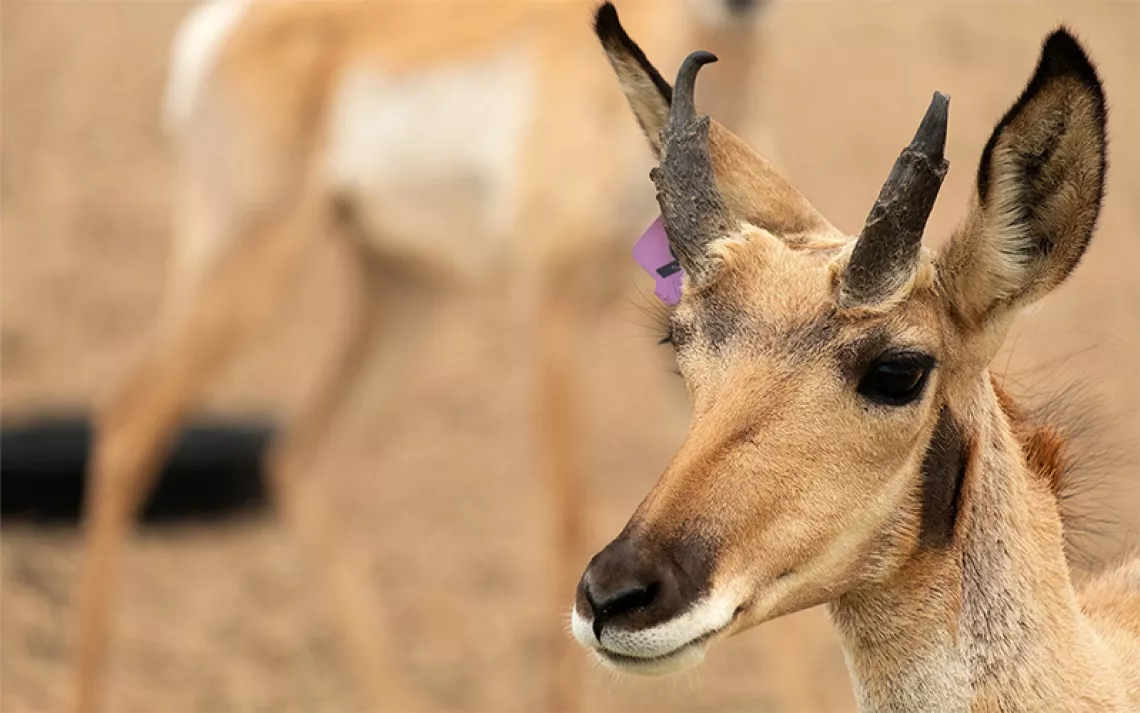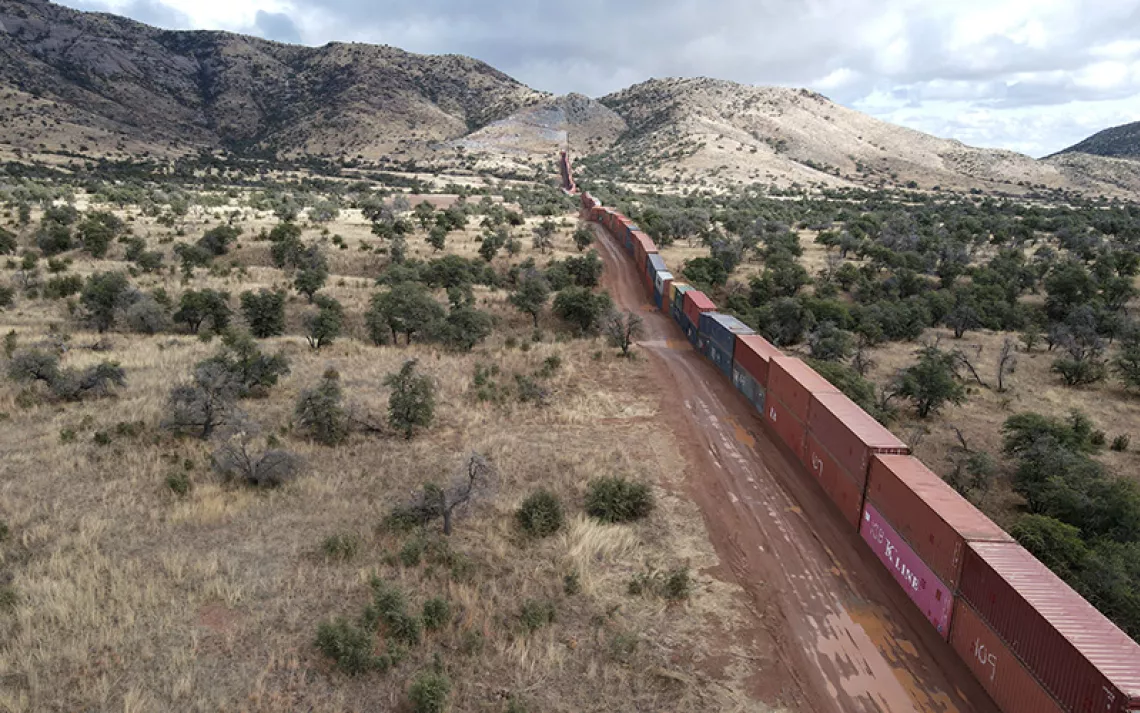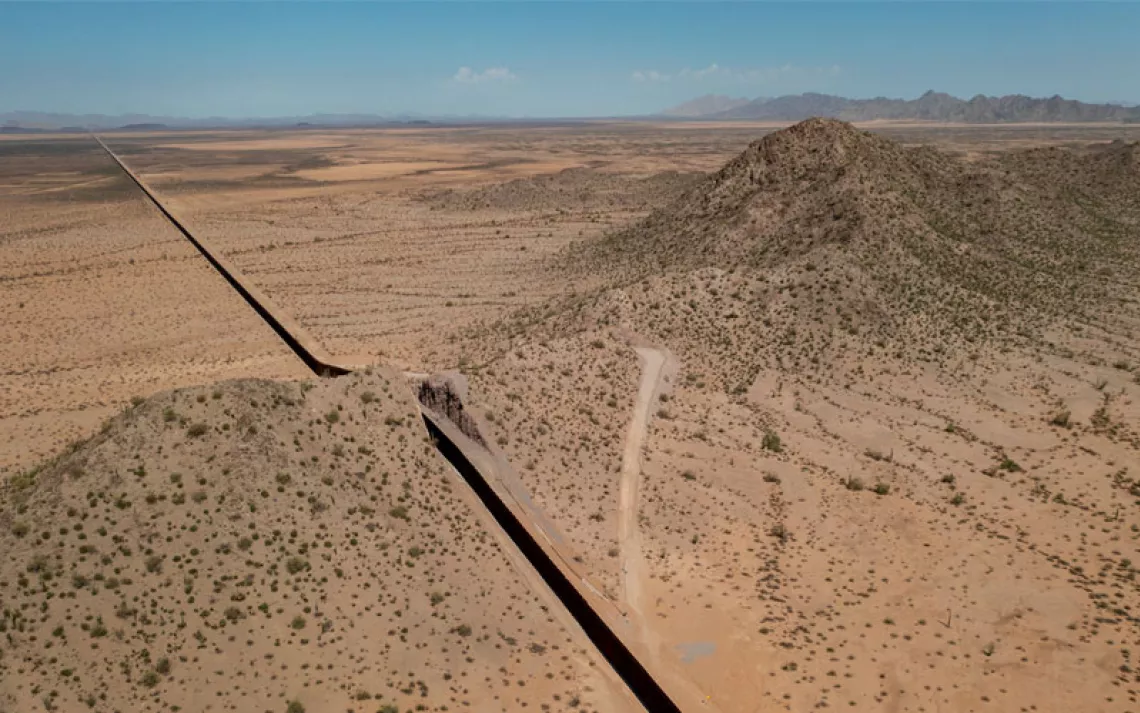Dispatch From the Border Wall
Inside Indigenous actions to stop construction on ancestral sites
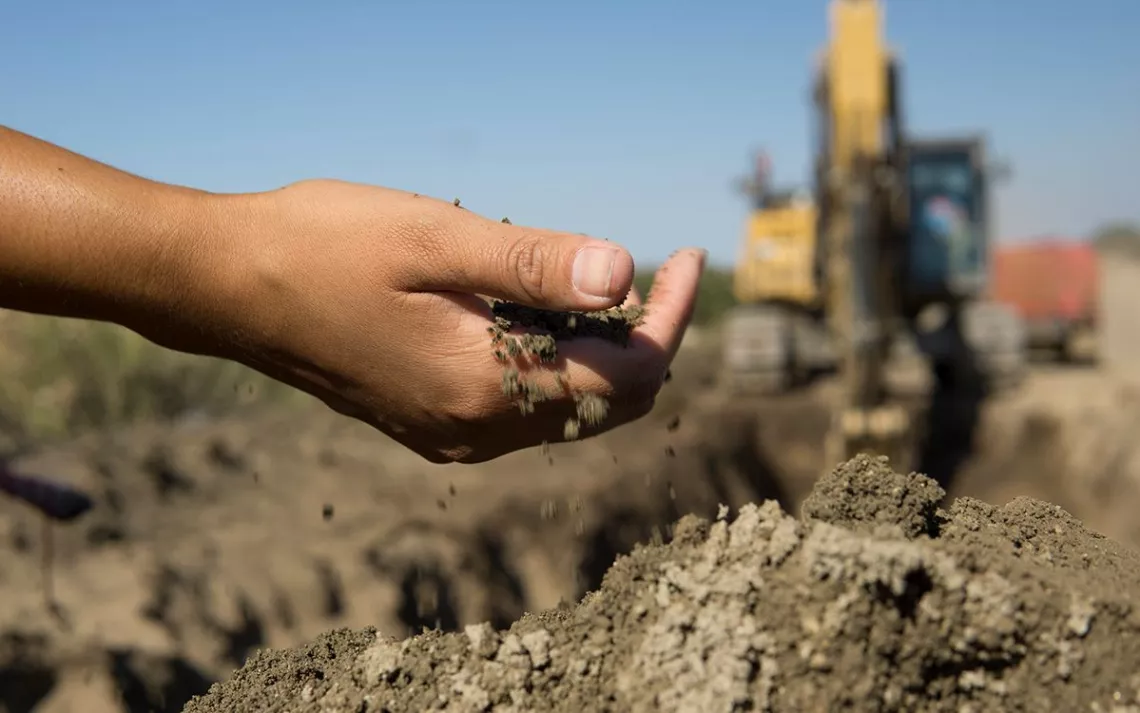
A Kumeyaay protester sifts the dirt-concrete mix through her hands as a border construction worker sits in his cab.
|Photos courtesy of James Stout
This piece has been updated since publication.
“When they blast into that soil, it feels like they’re tearing out my chest,” said Jamie LaBreak, a member of the Sycuan band of the Kumeyaay Nation. The afternoon of August 15, he stood before a circle of protesters gathered in the parking lot of a shuttered casino on Southern California’s La Posta Reservation. Sage smoke filled the hot, dry air. “Now let’s carry ourselves with dignity today,” he finished, as two dozen some members of SHIELD (Saving Homelands of the Indigenous and Ending Land Desecration) loaded up into a convoy of pickup trucks. The group drove south, cutting across unceded Kumeyaay land outside San Diego, en route to the US-Mexico border.
For more than 12,000 years, the Kumeyaay Nation’s 12 bands, now based on both sides of the border, have lived on this land. It is land now under threat, as the Trump administration rushes to complete more of its border wall before the election, ignoring Indigenous demands that construction respect ancestral remains. Planned to stretch for 14 miles along rugged terrain in the Laguna Mountains, the wall will cut through areas that the Kumeyaay Nation considers a culturally significant thoroughfare, infringe on their right to consultation on their own land, and desecrate the remains of their ancestors.
At the border, green-clad tactical teams from the Border Patrol looked on as SHIELD activists held a ceremony marked by song, dance, and burning sage. One protester knelt down over a trench, dug to provide a foundation for the wall, and sifted the earth through her fingers. “This is native soil, but they mix it to make concrete,” she said. “You can see in those first three feet [of the trench dug for the wall]; that’s 12,000 years of our history.”
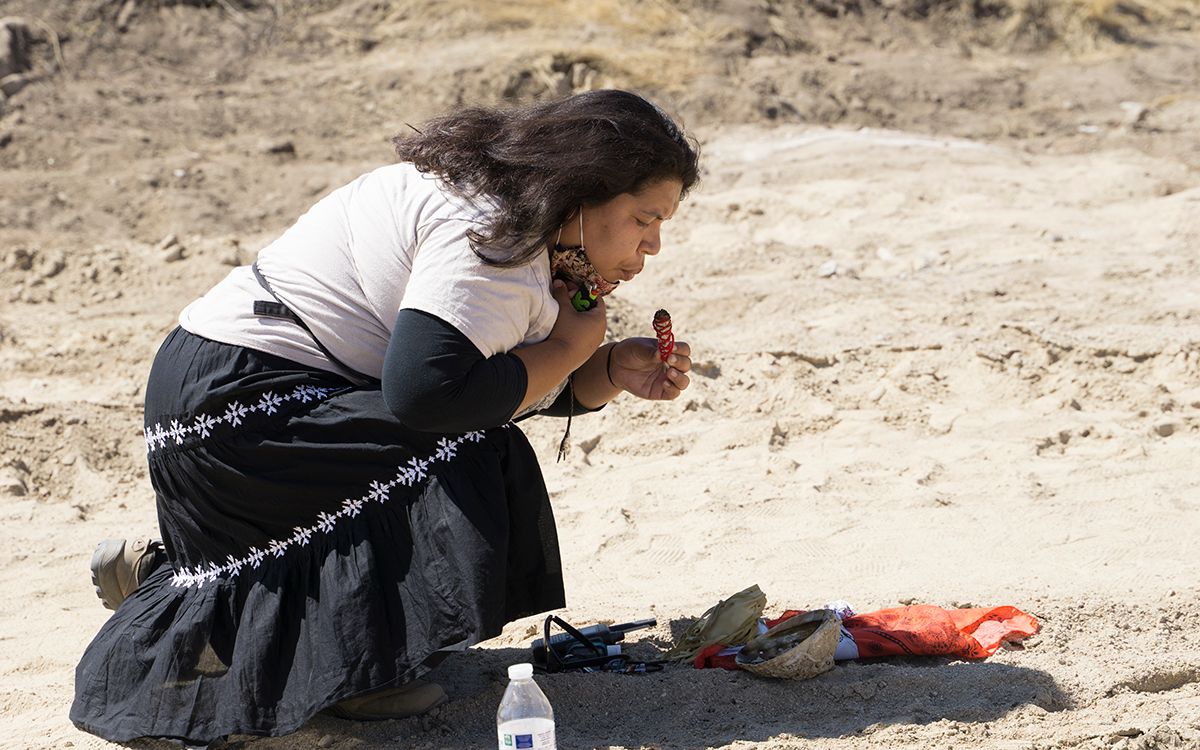
Burning sage is an important part of Kumeyaay ceremony.
According to the Native American Graves Protection and Repatriation Act (NAGPRA), enacted by Congress in 1990 to protect and safely relocate Native burial sites, when construction takes place on sensitive sites such as these, the tribe in question should be consulted. And in the event remains or other archaeological objects are found, construction should be altered so as not to disturb the site. Kumeyaay leaders, however, say they were not informed of border wall construction being carried out by civilian contractors on behalf of the Army Corps of Engineers. Members of the Kumeyaay say Customs and Border Protection, which is helping to manage the construction of the site, has ignored evidence of the cultural heritage sites they’re now building over. Members also say they first found out of plans to use explosives on the border when they first heard the first explosions.
On August 12, the Kumeyaay Nation’s La Posta Band of Diegueno Mission Indians filed a lawsuit against Secretary of Defense Mark Esper, who oversees the military funds that have been diverted for wall construction (Esper’s move was challenged by the Sierra Club and other environmental groups). The suit demands that tribal monitors be granted access to all dig sites, and that a complete geological survey be carried out before construction continues.
The Kumeyaay protests are largely youth-led and include several members of the various tribal councils, including 28-year-old Cynthia Parada (La Posta Band of Mission Indians), an administrator for the group’s online presence and a frequent leader at recent months’ protests, both at the wall and in downtown San Diego. While Kumeyaay protesters are generally opposed to the wall—which reinforces a border that divides them from their family to the south—their efforts aren’t so much about terminating its construction as they are about being kept abreast of the project and having an active role in ensuring that no sacred artifacts or remains are damaged.
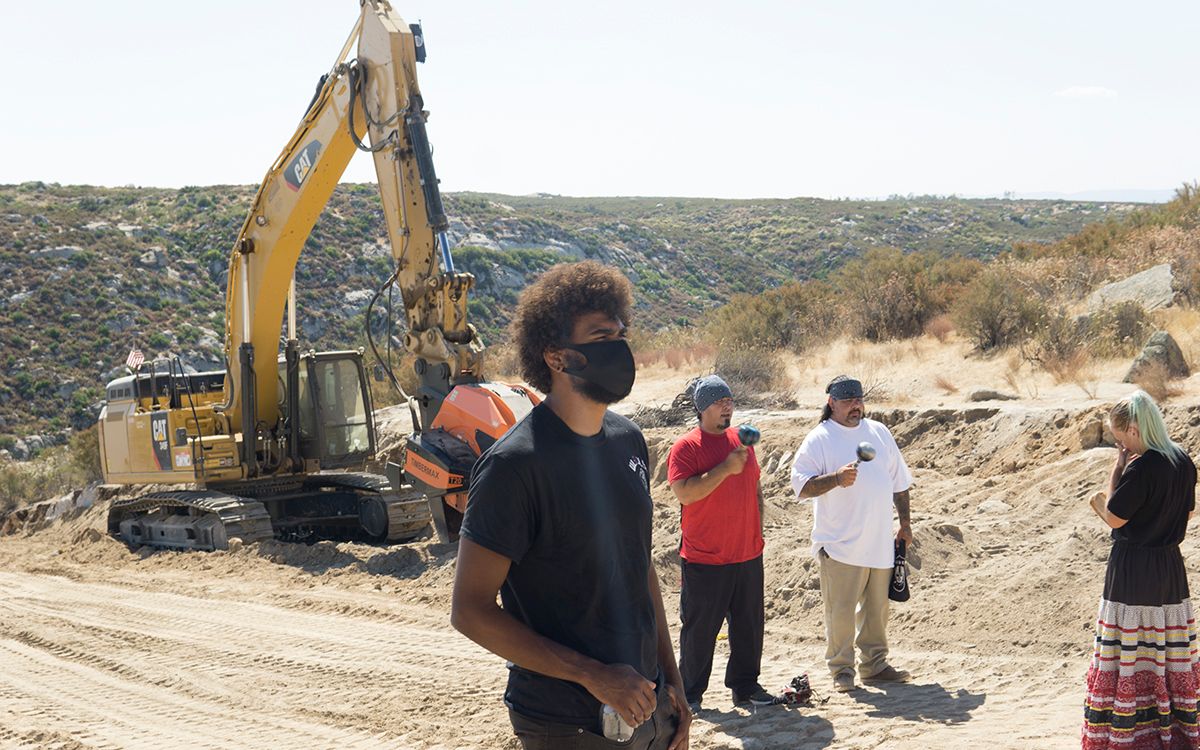
An ally looks on as singers perform in the path of construction vehicles.
But while monitors are currently provided by the Army Corps of Engineers, both the corps and Customs and Border Protection were unable to provide Sierra with information about how many monitors are in place or steps taken to consult with the Kumeyaay Nation.
Of the two sites protesters visited last week, only one monitor was observable. Yet construction workers were digging, blasting, and otherwise moving the earth on both sites. Between sites, they were taking soil and mixing it with concrete to provide a foundation for the wall, which reaches 30 feet high in places. This not only makes it near impossible to check all soil for human remains or artifacts, but also anchors a barrier that divides the nation. As one protester noted, “It’s not our soil anymore.”
2020 has been marked by protests. Last week’s calm and composed actions of the Kumeyaay protesters, however, were a far cry from the tear gas and truncheons so frequently featured in the news. The protesters aren’t “monkey wrenching” or shouting at construction workers; in fact, they pray for them and sometimes with them. LaBreak and other organizers warn protesters not to step off the road, as that would mean they’d be entering Mexico illegally. They inform protesters that if they use violence, the army could be deployed. Last week, when the protest group learned that one of the wall’s construction workers had recently lost a family member, they included him and his family in their prayers.
“They’re just workers, and none of them knew when they signed on they were coming to desecrate Native land,” one protester told Sierra. The Kumeyaay perform ceremonies at the wall, exercising their right to practice their religion, and in doing so, prevent construction from happening while they are there. “We just have to keep slowing things down, because we’ve got nothing but time,” Bobby Wallace of the Barona Band of Mission Indians told the group. “And then November will come around faster than snot on a stick.” The construction workers declined to be interviewed but watched from the cabs of their vehicles as bird singers and dancers in traditional dresses paid tribute to the land they were being paid to dig up.
Alongside ceremony, the Kumeyaay group looked out for midden soil, in other words “evidence of cremated human remains.” Monitors seek out ashy residue at construction sites, as it is indicative of midden soil and should according to law signal the need for further evaluation, through cadaver dogs and soil testing, before construction can continue. On August 13, Kumeyaay monitors indeed found midden soil in an area known as Smith Valley, of which they immediately informed on-site monitors with the Army Corps of Engineers. Construction in the area, however, was not halted. The next day the group stood in silence to consider their ancestors, whose remains they felt were being disturbed as digging continued across the valley.
“If this were another country’s government destroying a religion’s holy land, the US would go to war and the people would feel it justified,” activist Thomas Barbour told Sierra. “But it happens here at home in front of us, and we turn away.”
Currently, Smith Valley is being blasted. SHIELD activists had previously been told they couldn’t protest there because the dynamite used in wall construction made the area unsafe. However, protesters later found that most of the explosives had not even been placed in the ground. The area contains a small stream, edible plants, and as mentioned was the location of the recently discovered midden soil. According to archaeologists who joined the group, this all makes it highly likely that the area was a village site for the Kumeyaay, and likely also a cemetery. Normally any such site would be protected by 1990’s NAGPRA Act, or the National Historic Preservation Act of 1906, but the Department of Homeland Security has issued waivers for these laws and many others on the grounds of “national security.”
The land immediately adjacent to the border is part of what is known as the Roosevelt Reservation. Established by President Theodore Roosevelt in 1907 to inhibit smuggling, this 60-foot-wide cutout of land on the northern side of the US-Mexico border stretching from California to New Mexico is owned by the federal government. This exempts the land from tribal jurisdiction along the border and technically means the US government doesn’t recognize it as tribal land.
All of the United States, however, is Native land, meaning that even within the Roosevelt Reservation, Indigenous people have a right to protect their ancestral remains from desecration. Whether or not their lawsuit succeeds, representatives from the Kumeyaay Nation say they’ll continue protecting their land until November—or for as long as it takes to ensure that their ancestors are shown the respect they deserve.
Update: "On September 21, a Kumeyaay group called Kumeyaay Defense Against the Wall was evicted from a camp on the border by BLM and law enforcement. The group's Instagram page showed BLM agents issuing a "public lands closure notice" to the group, which had set up camp in one of the construction areas. Protesters' vehicles were blocked in with boulders and ditches, and then towed as abandoned vehicles. As of 10:50Am on September 21 the group was packing up, under the watch of tactical teams and armed officers from several federal and local jurisdictions."
 The Magazine of The Sierra Club
The Magazine of The Sierra Club

